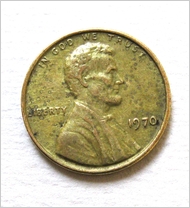
PREV ARTICLE
NEXT ARTICLE
FULL ISSUE
PREV FULL ISSUE
BROOKLYN WOMAN FINDS ARTIST'S CENT MADE OF GOLD
Max Spiegel and Dick Johnson forwarded this New York Times article about a "sculpture" a Brooklyn woman found in her change.
-Editor
He got a cup of coffee and sat down on a seat with the newsstand in sight, and watched for an hour wondering if any of the travelers had walked off with his golden penny and where it would end up at the end of the day. Most counterfeiting takes something that is nearly worthless and turns it into something perceived to have value. Mr. Daws did just the opposite. He took value — approximately $100 worth of gold — and turned it into something perceived as nearly worthless, one cent. "It's there, but if people don't realize it, it's the same as not being there," he said. Of the 11 copper-plated gold pennies he made as part of his series, only this one was sent into the wider world. He never expected to see it again, but he wondered where the penny ended up: stuck in a giant penny jar, melted down with other coins back at the United States Mint, lost in a street gutter. Meanwhile, one of his other counterfeit pennies sold for $1,000 to a collector through the Greg Kucera gallery. Then, Mr. Daws woke up one morning in October and listened to a voicemail left by a Brooklyn graphic designer named Jessica Reed. "I think I found your gold penny," the message said. How the golden penny traveled, through how many hands or cash registers, over the two years, may never be known. But now the journey has reached its endpoint. Late this summer, when Ms. Reed was paying for groceries at the C-Town supermarket in Greenpoint, she noticed the penny because the gold color had started to peek through. A fan of unusual coins, she slipped it back into her change purse and tucked it into the recesses of her mind. Then recently, while doing research about a 1924 Mercury-head dime, she remembered the penny and typed "gold penny" into Google, which returned information on science experiments to give a penny a gold color. She added "1970" and found an item about how Mr. Daws had put a 18-karat gold penny, dated 1970 with no mint mark, into circulation. It was heavier and smaller than a real penny. In disbelief, she weighed the penny on a digital scale. It came in at three grams, one gram more than similar pennies from 1970. And it was slightly smaller than a normal penny, owing to the shrinking after the casting process. She traced Mr. Daws's phone number through the gallery and left him the message. When he called back, he knew it had to be his penny as soon as she described it to him. Ms. Reed will keep the coin. She is thinking of having it framed. It's was a curious way to display a sculpture, she said. "I can't imagine being an artist who does something like this," she said. "It's the opposite of having your stuff shown in a gallery. It could be tossed."
To read the complete article, see:
Brooklyn Woman Finds Counterfeit Penny Made of Gold
(cityroom.blogs.nytimes.com/2009/11/04/
Here's a 2007 article about Daws spending the gold cent. It includes a "before" picture of the piece prior to circulation.
-Editor
Whoever finds the sculpture could sell it for the value of the gold, but they might want to hold onto it. Daws has more of them, and his Seattle art dealer, the Greg Kucera Gallery, is selling them. Prices start at $1000. When asked if he was concerned about possible criminal charges for counterfeiting, Daws replied, "If they're looking for criminals they should raid the White House and the Capitol." To read the complete article, see: Counterfeit Penny put in Circulation (www.gregkucera.com/daws.htm)
Numismatists know that our coins are miniature sculptures designed by some of the best artists of the day. And I wouldn't object to calling Daws' gold cent a work of art. But I don't think it deserves to be called a sculpture if it's simply a machine-made copy of a real coin in another metal. That's a derivative work, not an original one.
It's an interesting parallel to the performance art of J.S.G. Boggs, who "spent" his art works at face value; those who accepted them later learned they were actually worth much more to collectors. -Editor Wayne Homren, Editor The Numismatic Bibliomania Society is a non-profit organization promoting numismatic literature. See our web site at coinbooks.org. To submit items for publication in The E-Sylum, write to the Editor at this address: whomren@gmail.com To subscribe go to: https://my.binhost.com/lists/listinfo/esylum All Rights Reserved. NBS Home Page Contact the NBS webmaster 
|
 One afternoon in March 2007, Jack Daws stepped up to a newsstand in Los Angeles International Airport with a handful of change, including a counterfeit penny made of 18-karat gold that Mr. Daws, a Seattle artist, had fashioned. He carefully put the counterfeit penny, dated 1970, down on the counter, counted out enough change to pay $11.90 for a Hustler magazine and left.
One afternoon in March 2007, Jack Daws stepped up to a newsstand in Los Angeles International Airport with a handful of change, including a counterfeit penny made of 18-karat gold that Mr. Daws, a Seattle artist, had fashioned. He carefully put the counterfeit penny, dated 1970, down on the counter, counted out enough change to pay $11.90 for a Hustler magazine and left.
